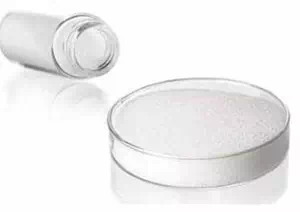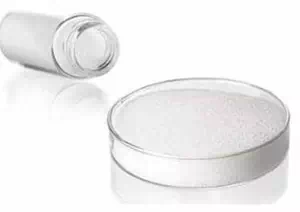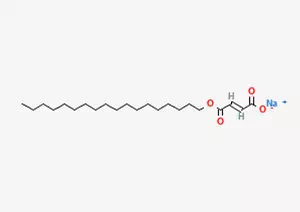All Categories



sodium stearyl fumarate CAS 4070-80-8, sodium stearyl fumarate, CAS 4070-80-8
Sodium stearyl fumarate plays a crucial role in the field of pharmaceutical excipients. It is a typical hydrophilic lubricant. It is widely used as a lubricant in the production process of drug preparations.
CAS : 4070-80-8
Formula : C22H41NaO4
Mol. wt. : 392.56
EINECS : 223-781-1
Chemical Name | Sodium Stearyl Fumarate |
Other Name | Sodium octadecyl fumarate; Monosodium stearyl fumarate; 2-Butenedioic acid (2E) – monooctadecyl ester, sodium salt |
CAS | 4070-80-8 |
EINECS | 223-781-1 |
Type | Food additives; Pharmaceutical raw materials; Organic raw materials; Pharmaceuticals, pesticides, dye intermediates |
Molecular Formula | C22H41NaO4 |
Molecular Weight | 392.56 |

Melting point | >196°C (dec.) |
storage temp. | Inert atmosphere,Room Temperature |
solubility | Practically insoluble in water, slightly soluble in methanol, practically insoluble in acetone and in anhydrous ethanol. |
color | White to Off-White |
In the field of chemical synthesis, the preparation of sodium stearate fumarate has a clear and specific reaction pathway. Firstly, stearic acid needs to be reacted with maleic anhydride. During this process, the molecules of stearic acid and maleic anhydride interact with each other. Through a series of complex chemical reactions, sodium stearate fumarate is ultimately obtained. However, this is not the end of the entire reaction process. Next, isomerization treatment of this reaction product is still needed to further convert it into the form of salt.
Sodium stearyl fumarate plays a crucial role in the field of pharmaceutical excipients. It is a typical hydrophilic lubricant. It is widely used as a lubricant in the production process of drug preparations. Compared with traditional magnesium stearate, sodium stearyl fumarate has many significant advantages and can effectively overcome many difficult problems that occur during the use of magnesium stearate. For example, when using magnesium stearate, it is often the case that the main drug is affected. This might be due to some unnecessary interactions between magnesium stearate and the drug, thereby affecting the stability and efficacy of the drug. In addition, magnesium stearate may also have the problem of excessive lubrication, which may lead to some unsatisfactory situations during the drug pressing process. Sodium stearoyl fumarate, on the other hand, can prevent these problems from occurring and provide a more reliable guarantee for the production of drug preparations.
The role of sodium stearyl fumarate in the preparation of effervescent tablets should not be underestimated either. It can form a special protective film inside the effervescent tablet. This protective film acts like a barrier and can effectively improve the disintegration characteristics of the effervescent tablet. Specifically, it enables the effervescent tablet to disintegrate at the expected speed and in the expected manner when it comes into contact with water or other solvents, rather than disintegrating too early or too late. Meanwhile, this protective film can also promote the dissolution of the drug, enabling the drug to be released from the preparation more quickly and fully, thereby enhancing the bioavailability of the drug and allowing it to exert better therapeutic effects in the body.
From the perspective of chemical synthesis, the generation of sodium stearate fumarate is a rigorous process. It is formed by the ring-opening esterification reaction of maleic anhydride and stearic alcohol. In this reaction, the cyclic structure of maleic anhydride opens and undergoes esterification with stearic alcohol to form the corresponding intermediate product. Subsequently, through isomerization reactions, the structure of the molecule undergoes specific changes, eventually generating a salt, namely sodium stearate fumarate.
Sodium stearoyl fumarate not only performs well in pharmaceutical preparations with strong compatibility, but also can be used as a tablet lubricant. During the tablet pressing process, it can effectively improve a series of problems caused by the traditional lubricant magnesium stearate, such as insufficient tablet strength, abnormal disintegration and difficult dissolution, etc. By using sodium stearoyl fumarate as a tablet pressing lubricant, the tablets can be made more uniform and stable during the pressing process, and the quality and performance of the tablets can be improved.
However, sodium stearoyl fumarate is not perfect either. It has extensive applications in fields such as food and chemical products. Although this wide application reflects its multi-functionality and practicality, in certain specific circumstances, it may also cause some potential problems. For example, when used in food, its dosage and usage conditions need to be strictly controlled to ensure food safety. When used in chemical products, it is also necessary to take into account its interaction with other components and its impact on the performance of the final product, etc.

In today's pharmaceutical and food industries, sodium stearoyl fumarate (C22H39NaO4) is undoubtedly a widely used and crucial excipient. It plays an indispensable role in many fields. Its unique chemical properties and excellent application effects make it an indispensable part of the pharmaceutical and food industries.
The metabolic process of sodium stearoyl fumarate in animals is a complex yet orderly one. When it enters the animal's body, most of it will be absorbed and hydrolyzed through a series of physiological reactions. During this process, it will gradually decompose to form stearol and stearic acid. These two substances have their own metabolic pathways and functions in the animal body. A small portion of sodium stearyl fumarate can be metabolized directly and rapidly. It is worth noting that this substance does not produce any toxic substances during the metabolic process and does not cause any irritation to the animal body. This undoubtedly provides a strong guarantee for its safe application in the fields of medicine and food.
In the field of pharmaceuticals, the application of sodium stearyl fumarate is extremely extensive and crucial. During the production process of drug preparations, it is often carefully added to various drug preparations and plays multiple important functions. For instance, it can be used as an efficient lubricant and is widely applied in the production process of tablets and capsules. During the tablet pressing process, sodium stearoyl fumarate can form a uniform lubricating film between the mold and the drug powder, effectively reducing the friction between the drug particles and the mold, making the tablet pressing process smoother and thereby improving the quality of the tablets and production efficiency. For capsules, it can also play a lubricating role, ensuring the smooth filling and sealing process of the capsules and avoiding problems such as cracking or deformation during the production process.
In addition, sodium stearyl fumarate plays a unique role in the production of effervescent tablets. It can form a protective film on the surface of the effervescent tablet. This protective film is like a solid barrier and can effectively solve some problems that may occur during the use of stearic acid-based lubricants. For instance, stearic acid-based lubricants may cause instability of drug components or affect the disintegration rate of drugs in some cases, while the protective film formed by sodium stearyl fumarate can prevent these problems from occurring. Meanwhile, this protective film can also improve the disintegration performance of the drug, enabling it to disintegrate more quickly when exposed to moisture or other solvents, thereby promoting the dissolution of the drug, enhancing its bioavailability, and allowing the drug to better exert its therapeutic effect.
In the field of food, sodium stearyl fumarate also holds an important position. The U.S. Food and Drug Administration (FDA) explicitly allows sodium stearyl fumarate to be directly added to food consumed by humans as a regulator and stabilizer. This regulation fully demonstrates its safety and reliability. In actual food production, sodium stearyl fumarate is widely used in the manufacturing processes of various baked goods, flour thickening foods, dried potatoes, and processed grains, among others.
Take baked goods as an example. When making bread, biscuits and other baked goods, sodium stearyl fumarate can be used as a regulator to help adjust the structure and texture of the dough, so that the baked goods have a better taste and appearance. In flour-based thickened foods, it can act as a stabilizer, preventing phenomena such as stratification and sedimentation during storage and transportation, and extending the shelf life of the food. For foods such as dried potatoes and processed grains, the addition of sodium stearyl fumarate can also improve the quality and taste of the food, making it more in line with consumers' taste demands.
Moreover, there are clear regulations on the addition amount of sodium stearyl fumarate in food. The addition amount can account for 0.2% to 1.0% of the food weight. This strict addition amount range has been verified through extensive scientific research and practice. It can not only ensure that sodium stearoyl fumarate plays the best regulatory and stabilizing role in food, but also guarantee the safety and health of food, allowing consumers to consume food containing sodium stearoyl fumarate with confidence.
* Prompt reply and 24 hours online, professional team to provide best price and high quality product.
* Sample testing support.
* Every batch of products will be tested to ensureits quality.
*The packing also can be according the customers` requirment.
*Any inquiries will be replied within 24 hours.
*we provide Commerical Invoice, Packing List, Bill of loading, COA , Health certificate and Origin certificate. If your markets have any special requirements, let us know.